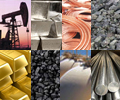Commodity Tracker: 4 charts to watch this week

1. Met coal prices surge, but market cautious on Evergrande impact

What’s happening? Coking coal has surpassed iron ore to become the most expensive raw material input for global steel makers, following a blistering rally in prices in recent weeks. Benchmark Platts Premium Low Vol HCC hit a 10-year high of $379/mt FOB Australia Sept. 16. Prices have remained elevated, closing at $402/mt Sept. 24. Delivered prices to China are also reaching new heights, and stood at $586/mt Sept. 24. The rally in coking coal was partly driven by the recent collapse in iron ore prices. The iron ore benchmark Platts IODEX 62% Fe was at 110.15/mt CFR China Sept. 24, down more than 50% since mid-July. Consequently, the overall input cost for coking coal has risen to between 50% and 60% for some end users in Europe and India. Meanwhile, the trend was even worse in China, with coking coal rising up to 70% of the hot metal production cost, across some east coastal steel mills.
What’s next? Market participants are closely watching the Q4 Chinese crude steel production controls as well as downstream steel consumption, which may potentially be impacted by a possible downfall of Chinese property developer Evergrande. Such factors could negatively impact both iron ore and coking coal prices in China. Some market participants anticipate easing domestic supply tightness of coking coal in Q4, resulting in reduced Chinese import demand. However, there is still a general consensus that the current supply tightness will sustain prices in the near-term.
2. China ratchets up climate commitment ahead of pre-COP26 summit in Milan…
 What’s happening? In a pre-recorded address to the UN’s General Assembly Sept. 21, China’s President Xi Jinping said China would cease financing of new coal-fired power plants abroad, and step up support for other countries to develop green and low-carbon energy. He said China would also strive to ensure its own carbon emissions peak “before 2030,” rather than by 2030, as previously stated. What looked like relatively modest steps could in fact be significant for the countries concerned. As of early 2021 China was supporting some 27 GW of coal-fired generation development mainly in South Asia and Southeast Asia—close to the size of Poland’s entire coal fleet.
What’s happening? In a pre-recorded address to the UN’s General Assembly Sept. 21, China’s President Xi Jinping said China would cease financing of new coal-fired power plants abroad, and step up support for other countries to develop green and low-carbon energy. He said China would also strive to ensure its own carbon emissions peak “before 2030,” rather than by 2030, as previously stated. What looked like relatively modest steps could in fact be significant for the countries concerned. As of early 2021 China was supporting some 27 GW of coal-fired generation development mainly in South Asia and Southeast Asia—close to the size of Poland’s entire coal fleet.
What’s next? Italy is hosting this year’s pre-COP summit in Milan Sept. 30—a key preparatory gathering of energy and climate ministers from up to 50 countries to frame discussions at the main event in Glasgow in November. It is not known yet whether China will attend COP26 in Glasgow, but its engagement on coal has given the UN talks a late boost. The next stage is for China, the world’s biggest emitter of CO2, to detail how it intends to get to net-zero by 2060. The projected cost is eye-watering. China would need Yuan 136 trillion ($21.1 trillion) of investments—around $500 billion a year on average—to reach carbon neutrality by 2060, according to Zhang Shaogang, vice chairman of China Council for the Promotion of International Trade. To get on trajectory to meet the UN’s Paris Agreement on global warming, it needs to cut nearly 70% of its coal consumption by 2050.
3. …while carbon emission controls back home bring uncertainties to petrochemicals market

What’s happening? The Asian benzene-naphtha spread has fallen to its lowest levels in six months, with benzene falling below $1,000/mt on downstream demand uncertainty. Concerns were mainly on carbon emission controls in China, a major importer, which could impact run rates among downstream producers. Meanwhile, the Asian naphtha market is seeing supply tightness. About 16% of oil and gas production in the US Gulf remain offline, according to the US Bureau of Safety and Environmental Enforcement, in the aftermath of Hurricane Ida.
What’s next? Uncertainties around the implications from China’s emission controls could keep the Asian benzene-naphtha spread in a weakening trend in Q4. October arrivals of benzene, a key feedstock used to produce other petrochemical products such as styrene, phenol, caprolactam and aniline, are still in queue and waiting to be offloaded in China. Operations in the US Gulf are expected to gradually recover from hurricane-related disruptions. As winter approaches, markets will be looking to the oil market for directional cues.
4. Cautious optimism among Asian refiners amid ESG push

What’s happening? Asia refiners are remaining cautiously optimistic about the region’s transportation fuel demand fully recovering to pre-pandemic levels by Q1 2022. At the same time, they are also eyeing a balance between maintaining middle distillates output and enhancing their environmental, social and governance profiles. This requires adjustments in feedstock choices and product slates.
What’s next? Of 11 major Asian refiners and other companies surveyed by S&P Global Platts, seven entities said Asia’s oil product demand could climb back to 2019 levels by February-March 2022, while three expect full recovery by May-June 2022. Although middle distillate products will likely be the main income source for Asian refiners, they are increasingly keen to regularly buy European and Australian crude oil regardless of spot market premiums, to fill their monthly feedstock baskets with crude and condensate certified as carbon neutral. They are also setting aside a certain proportion of their transportation fuel output for green energy products and this trend is expected to extend into the future as climate change action looms.
Source: Platts

 Hellenic Shipping News Worldwide Hellenic Shipping News Worldwide, Online Daily Newspaper on Hellenic and International Shipping
Hellenic Shipping News Worldwide Hellenic Shipping News Worldwide, Online Daily Newspaper on Hellenic and International Shipping





















 PG-Software
PG-Software